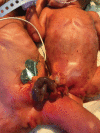Emergency Separation of Extreme VLBW Omphalopagus Twins: Case Report
- PMID: 35795172
- PMCID: PMC9252611
- DOI: 10.1055/s-0042-1750134
Emergency Separation of Extreme VLBW Omphalopagus Twins: Case Report
Erratum in
-
Erratum to: Emergency Separation of Extreme VLBW Omphalopagus Twins: Case Report.European J Pediatr Surg Rep. 2022 Aug 23;10(1):e126. doi: 10.1055/s-0042-1755532. eCollection 2022 Jan. European J Pediatr Surg Rep. 2022. PMID: 36016647 Free PMC article.
Abstract
The classification of conjoint twins is based according to the site of attachment. The challenges in management of such anomalies span the entire continuum of care from delivery to resuscitation to separation and finally discharge. Scheduled separation is ideal, occasionally the caring team is faced with no option but to perform an emergent separation. Omphalopagus is a type of conjoined twinning characterized by union of the peritoneal cavities through an infraumbilical abdominal wall defect. In this report we describe our experience with a successful emergency separation of extremely preterm omphalopagus twins. This is the first case of conjoint twins in Kuwait, we highlight the challenges faced, stressing the importance of adhering to antenatal care as well as management by a multidisciplinary team.
Keywords: bladder exstrophy; conjoined twins; omphalopagus twins.
The Author(s). This is an open access article published by Thieme under the terms of the Creative Commons Attribution License, permitting unrestricted use, distribution, and reproduction so long as the original work is properly cited. ( https://creativecommons.org/licenses/by/4.0/ ).
Conflict of interest statement
Conflict of Interest None declared.
Figures





References
-
- Weber M A, Sebire N J. Genetics and developmental pathology of twinning. Semin Fetal Neonatal Med. 2010;15(06):313–318. - PubMed
-
- Votteler T P. Surgical separation of conjoined twins. AORN J. 1982;35(01):35–46. - PubMed
-
- Konig G.Sibi Invicem adnati Feliciter separati, Ephemerid Natur Curios DecII, Ann VIII, Obs. 145,1689
-
- Kaufman M H.The embryology of conjoined twins Childs Nerv Syst 200420(8-9):508–525. - PubMed
Publication types
LinkOut - more resources
Full Text Sources

